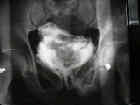- Urinary Injuries:

- see: renal / urogenital trauma
- frx patterns at risk:
- Malgaigne frx: rupture of bladder & urethra occurs in 20 % of patients;
- pubic rami frx: (especially from straddle injuries);
- urinary injuries common w/ pubic diastasis & frx of pubic rami;
- prevalance of injury is < 20% w/ unilateral injuries but may be over 40 w/ bilateral pubic ramus frx;
- evaluation of hematuria:
- male urethral injuries:
- anatomy:
- male urethra may be divided into anterior and posterior portions;
- posterior urethra consists of the prostatic and membranous segments;
- prostatic urethra is about 3.0 cm long and traverses the prostate gland between the bladder neck and verumontanum;
- membranous urethra:
- 2.0 to 2.5 cm long
- it traverses and is firmly fixed to the urogenital diaphragm;
- urethral injury is most common in the bulbomembranous urethral junction with the prostate;
- w/ posterior urethra injury, extravascation of contrast material is classically seen above the genitourinary diaphragm, but in practice, extravasation also occurs below the diaphram;
- urethral injuries occur in upto 15% of men but rare in women;
- in males supramembranous portion of urethra (? bulbous urethra) is most common site of injury;
- injury may also occur in the cavernous and or prostatic portion of the urethra.
- indicators of urethral injury:
- blood at the meatus;
- high-riding prostate on rectal examination;
- straddle-type fracture of pelvic ring;
- management:
- patients with displaced rami fractures and sacroiliac joint disruptions may be at especially high risk of urethral injuries, and consideration is given to initial retrograde urethrograms before urethral instrumentation;
- w/ suspected urethral injury perform retrograde cytourthrogram prior to attempted foley insertion (goal is to avoid completing a partial tear or contaminating a retroperitoneal hematoma);
- if RUG is positive, then a suprapubic cystostomy tube needs to be inserted;
- consider need for angiography before performing RUG since extravasation of contrast medium from bladder rupture could potentially cloud findings on arteriography;
- if foley has been inserted into a patient with a suspected urethral injury, a pericatheter retrograde urethrogram can be performed;
- w/ partial urethral tear, attempt catheter placement as the initial treatment;
- controversies:
- management of anterior symphyseal injuries w/ concomitant urethra injury:
- consider anterior plating of symphyseal injuries at either the time of supra-pubic catheter insertion or within a 24-48 hour window;
- after 48 hours, risk of infection is unacceptably high;

- bladder rupture:
- requires prompt diagnosis so as to avoid hyperkalemia, hypernatremia, uremia, acidosis, and peritonitis;
- can be extraperitoneal or intraperitoneal (or both);
- extraperitoneal rupture:
- most often, the rupture is anterior and extraperitoneal;
- in rare may result from laceration from sharp bone spike;
- in many cases, may be treated non operatively w/ suprapubic drainage;
- intraperitoneal rupture:
- occurs in about 15% of major pelvic fractures;
- most often occurs from contussion to lower abdomen or to the symphyseal region;
- may occurs w/o associated pelvic ring disruptions as the result of a seatbelt or steering wheel injury;
- usually requires operative correction;
- Rectal & Gastrointestinal Injury
- occur in less than 1% of pelvic fractures;
- may include lacerations of the rectum, perforations of small or large bowel;
- often rectal tears will be accompanying by perineal wounds;
- during the rectal examination, the examiner can gently palpate the sacrum for tenderness or asymmetry;
- if rectal exam is suspicious, then consider Renografin enema;
- when rectal laceration is present, diverting colostomy is often indicated, accompanied by thorough irrigation and debridement of frx communicating with the laceration;
- there is some indication that colosotomy diversion does not necessarily reduce incidence of infection;
- ref: Open pelvic fracture and fecal diversion.
- consequences of a missed rectal tear include contamination and infection of the retroperitoneal hematoma;
- always consider the possibility of rectal perforation in any patient w/ pelvic frx w/ unexplained fever, elevated WBC, abdominal tenderness;
- w/ these injuries consider need for external fixation;
- Gynecologic Injury
- may involve lacerations of vagina
- results from dislocations of symphysis pubis or frxs of pubic rami;
- larger peritoneal lacerations can involve the perineum and rectum;
- urethral injuries in females are uncommon;
- female urethra is short and mobile and less susceptible to injury as compared to the male urethra;
- inferior pubic ramus fractures that produce vaginal impingement are treated operatively
Trauma to the pelvis: Urethral injury.
Risk factors and mechanism of urethral injury in pelvic fractures.
Trauma to the Adult Pelvis and Hip. Management of Pelvic Fractures with Concomitant Urologic Injuries.
Our results of surgical management of unstable pelvic ring injuries
High Rates of Sexual and Urinary Dysfunction After Surgically Treated Displaced Pelvic Ring Injuries

